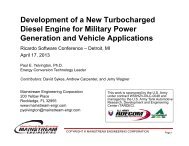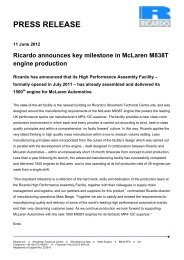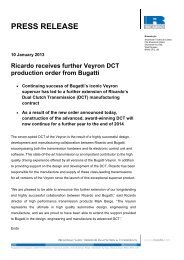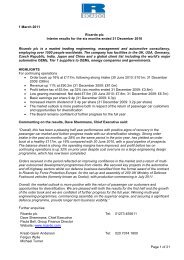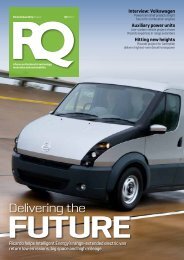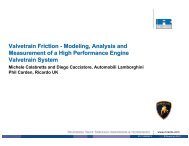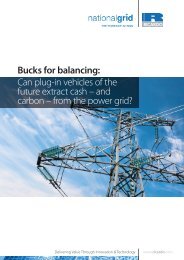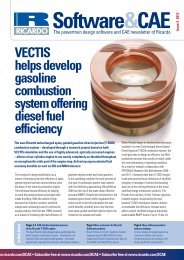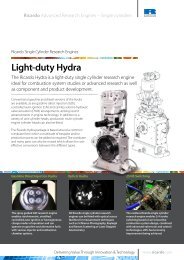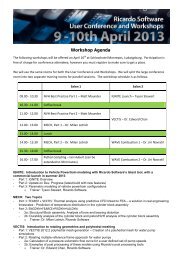Modelling waste heat recovery with a turbogenerator on a ... - Ricardo
Modelling waste heat recovery with a turbogenerator on a ... - Ricardo
Modelling waste heat recovery with a turbogenerator on a ... - Ricardo
You also want an ePaper? Increase the reach of your titles
YUMPU automatically turns print PDFs into web optimized ePapers that Google loves.
<str<strong>on</strong>g>Modelling</str<strong>on</strong>g> <str<strong>on</strong>g>waste</str<strong>on</strong>g> <str<strong>on</strong>g>heat</str<strong>on</strong>g> <str<strong>on</strong>g>recovery</str<strong>on</strong>g> <str<strong>on</strong>g>with</str<strong>on</strong>g> a<br />
<str<strong>on</strong>g>turbogenerator</str<strong>on</strong>g> <strong>on</strong> a diesel engine<br />
A presentati<strong>on</strong> to the <strong>Ricardo</strong> European User C<strong>on</strong>ference<br />
Ian Briggs<br />
Queen’s University Belfast<br />
Geoff McCullough<br />
Stephen Spence<br />
Roy Douglas<br />
Richard O’Shaughnessy Queen’s University Belfast<br />
27 th March 2012<br />
Alister Hanna<br />
Cedric Rouaud<br />
Rachel Seaman<br />
Wrightbus Ltd.<br />
<strong>Ricardo</strong> Ltd.<br />
Revolve Technologies Ltd.<br />
© 2012, The Queen’s University of Belfast
Acknowledgement<br />
• The authors would like to acknowledge the UK Technology Strategy<br />
Board and Invest Northern Ireland for the financial support in the<br />
Project ‘TERS – Thermal Energy Recovery Systems’<br />
• Also, Wrightbus, Revolve and <strong>Ricardo</strong> for their technical c<strong>on</strong>tributi<strong>on</strong>s<br />
© 2012, The Queen’s University of Belfast<br />
2
C<strong>on</strong>tents<br />
• Introducti<strong>on</strong><br />
– Project Background<br />
– Overview<br />
• Waste Heat Recovery Project<br />
– Engine <str<strong>on</strong>g>Modelling</str<strong>on</strong>g><br />
– Waste <str<strong>on</strong>g>heat</str<strong>on</strong>g> <str<strong>on</strong>g>recovery</str<strong>on</strong>g> modelling<br />
• Results<br />
• Optimisati<strong>on</strong><br />
• C<strong>on</strong>clusi<strong>on</strong>s<br />
• Future Work<br />
© 2012, The Queen’s University of Belfast<br />
3
Introducti<strong>on</strong><br />
• Background<br />
– Project funded by Technology Strategy Board / Invest Northern Ireland<br />
– Collaborati<strong>on</strong> between three commercial partners (Wrightbus Ltd, <strong>Ricardo</strong> Ltd<br />
and Revolve Technologies Ltd) and three post-graduate students at QUB<br />
– Researching thermal management of a Wrightbus hybrid bus<br />
• Project Aims & Objectives<br />
– Work in c<strong>on</strong>juncti<strong>on</strong> <str<strong>on</strong>g>with</str<strong>on</strong>g> the group members to reduce fuel c<strong>on</strong>sumpti<strong>on</strong> <strong>on</strong><br />
Wrightbus’ hybrid bus<br />
– Collectively, we aim to achieve 10% reducti<strong>on</strong> in fuel c<strong>on</strong>sumpti<strong>on</strong> using<br />
turbocompounding and Rankine cycles <strong>on</strong> exhaust line and cooling circuit<br />
– Apply turbocompounding to the hybrid bus engine to recover <str<strong>on</strong>g>waste</str<strong>on</strong>g>d energy<br />
and reduce fuel c<strong>on</strong>sumpti<strong>on</strong> (via the creati<strong>on</strong> of a computati<strong>on</strong>al model)<br />
© 2012, The Queen’s University of Belfast<br />
4
Waste Heat Recovery<br />
• These factors have driven the aims of this project<br />
• These problems may be addressed by recovering <str<strong>on</strong>g>waste</str<strong>on</strong>g>d <str<strong>on</strong>g>heat</str<strong>on</strong>g> from an<br />
Internal Combusti<strong>on</strong> Engine<br />
• Approx. 30% of fuel energy is <str<strong>on</strong>g>waste</str<strong>on</strong>g>d through the exhaust<br />
– Offers a large potential to recover energy<br />
• Even a small reducti<strong>on</strong> in <str<strong>on</strong>g>waste</str<strong>on</strong>g> <str<strong>on</strong>g>heat</str<strong>on</strong>g> can<br />
lead to significant improvements in<br />
fuel c<strong>on</strong>sumpti<strong>on</strong><br />
© 2012, The Queen’s University of Belfast<br />
5
Turbocompounding<br />
• Three main forms of turbocompounding:<br />
Mechanical Turbocompound<br />
• Uses a Power Turbine to<br />
extract energy from<br />
exhaust gas<br />
• Large, heavy system<br />
• Complex operati<strong>on</strong><br />
• Limited methods of using<br />
the generated power<br />
Figure adapted from: C. Vuk, "Turbo Compounding: A Technology Who's Time Has Come", Proc. 11th Diesel Engine Emissi<strong>on</strong>s Reducti<strong>on</strong><br />
(DEER) C<strong>on</strong>f., Chicago, USA, 2005.<br />
© 2012, The Queen’s University of Belfast<br />
6
Turbocompounding<br />
• Three main forms of turbocompounding:<br />
Electric Turbocharger<br />
• Small motor/generator<br />
mounted <strong>on</strong> the<br />
turbocharger shaft<br />
• Very small package<br />
• Can be used to generate<br />
power or to help spin the<br />
turbocharger<br />
• Requires a redesign of the<br />
existing turbocharger<br />
Figure adapted from: F. Gerke, “Diesel Engine Waste Heat Recovery Utilizing Electric Turbocompound Technology”, Proc. 7th Diesel Engine<br />
Emissi<strong>on</strong>s Reducti<strong>on</strong> (DEER) Workshop, Portsmouth, USA, 2001.<br />
© 2012, The Queen’s University of Belfast<br />
7
Turbocompounding<br />
• Three main forms of turbocompounding:<br />
Turbogenerator<br />
• Power turbine c<strong>on</strong>nected<br />
to a small generator<br />
• Mounted downstream of<br />
the turbocharger turbine<br />
• Small package, light<br />
weight<br />
• Ideally suited to the hybrid<br />
bus applicati<strong>on</strong><br />
Figure adapted from: Green Car C<strong>on</strong>gress, CPT Brings TIGERS Technology to VIPER Project for Enhanced Energy Recovery. [Online]. Available:<br />
http://www.greencarc<strong>on</strong>gress.com/2010/09/cpt-20100923.html [Accessed: 2 Nov 2010]<br />
© 2012, The Queen’s University of Belfast<br />
8
Turbocompounding<br />
Fuel Energy<br />
Power Generated<br />
Turbogenerator<br />
Compressed Air<br />
Turbocharger<br />
Intake Air<br />
© 2012, The Queen’s University of Belfast<br />
9
<str<strong>on</strong>g>Modelling</str<strong>on</strong>g> Strategy<br />
Obtain Geometry<br />
Measurements from Engine<br />
Create baseline engine model<br />
using WAVE<br />
Validate baseline engine model<br />
against experimental data<br />
Activate <str<strong>on</strong>g>turbogenerator</str<strong>on</strong>g> in<br />
Engine Model<br />
Assess effect of <str<strong>on</strong>g>heat</str<strong>on</strong>g> <str<strong>on</strong>g>recovery</str<strong>on</strong>g><br />
<strong>on</strong> fuel c<strong>on</strong>sumpti<strong>on</strong><br />
Optimise the <str<strong>on</strong>g>turbogenerator</str<strong>on</strong>g><br />
Optimise the engine package<br />
© 2012, The Queen’s University of Belfast<br />
10
Engine Model C<strong>on</strong>structi<strong>on</strong><br />
EGR Valve<br />
• Engine Model (WAVE)<br />
PID 3<br />
EGR Cooler<br />
PID 1<br />
Turbogenerator<br />
Turbine<br />
Turbocharger<br />
Turbine<br />
Exhaust Aftertreatment<br />
Turbocharger<br />
Compressor<br />
Inlet Manifold<br />
Exhaust Ports &<br />
Intake Ports Manifold<br />
Fuel Injectors Engine<br />
Air Filter Block<br />
PID 2<br />
© 2012, The Queen’s University of Belfast<br />
11
Baseline Model Validati<strong>on</strong><br />
• Baseline model validati<strong>on</strong><br />
– The model has been validated<br />
across the full operating range of<br />
test data<br />
– Error is less than 2% over the<br />
majority of the operating range<br />
– Particularly at the four most<br />
frequently accessed points of<br />
drive cycle (Pts 1-4)<br />
• Thus, we have c<strong>on</strong>fidence in the<br />
model’s ability to predict the<br />
current engine performance<br />
© 2012, The Queen’s University of Belfast<br />
12
Turbogenerator Model<br />
• Initial runs simply ‘switched <strong>on</strong>’ the <str<strong>on</strong>g>turbogenerator</str<strong>on</strong>g><br />
Power Turbine<br />
Bypass Valve<br />
• Bypass Valve open = Baseline C<strong>on</strong>figurati<strong>on</strong><br />
• Bypass Valve Closed = Turbogenerator Activated<br />
© 2012, The Queen’s University of Belfast<br />
13
Turbogenerator Model<br />
• Using a generic scaled turbine performance<br />
map for values of:<br />
– Pressure Ratio<br />
– Mass Flow<br />
– Shaft Speed<br />
– Efficiency<br />
• Using the four comm<strong>on</strong>ly accessed<br />
points (Pts 1-4) plus <strong>on</strong>e other midload<br />
point (Pt 5)<br />
• Matched AFR and torque<br />
– Manual process for each case by adjusting gain <strong>on</strong> PID c<strong>on</strong>trollers<br />
• Initial turbine map created a peak power output of 4.6kW <strong>on</strong> the<br />
<str<strong>on</strong>g>turbogenerator</str<strong>on</strong>g> at full engine load<br />
© 2012, The Queen’s University of Belfast<br />
14
Turbogenerator Model Results<br />
• 4.6kW Power turbine results:<br />
Operating Point P TG (kW) Δ BSFC<br />
Pt 1 0.01 -0.12%<br />
Pt 2 0.31 -1.03%<br />
Pt 3 1.66 -1.55%<br />
Pt 4 4.57 -2.37%<br />
Pt 5 3.46 -1.24%<br />
• Peak reducti<strong>on</strong> in BSFC of almost 2.4%<br />
• Represents a modest improvement in fuel c<strong>on</strong>sumpti<strong>on</strong><br />
• Turbine map was then scaled to investigate the effects of a more powerful<br />
device:<br />
• Four other devices created (up to 11.5kW)<br />
• Shaft speed limited to 80,000rpm<br />
© 2012, The Queen’s University of Belfast<br />
15
Turbogenerator Model Results<br />
• 9.2kW device represents a peak BSFC improvement of 4.4%<br />
• A larger device c<strong>on</strong>tinues to improve BSFC performance at other load<br />
points<br />
• Highlights the difficulty in choosing a device for off-design c<strong>on</strong>diti<strong>on</strong>s<br />
• These results involve no turbocharger matching (due to cost reas<strong>on</strong>s)<br />
© 2012, The Queen’s University of Belfast<br />
16
Energy Audit<br />
• To understand the results, an energy audit was performed for the engine<br />
• This looks at the main losses in the engine, via the distributi<strong>on</strong> of fuel<br />
energy supplied:<br />
– Brake Work;<br />
– Pumping Work;<br />
– Heat Transfer through the cylinder walls;<br />
– Wasted <str<strong>on</strong>g>heat</str<strong>on</strong>g> in the exhaust gas;<br />
– Energy lost to fricti<strong>on</strong>;<br />
– Energy lost due to combusti<strong>on</strong> inefficiency.<br />
• Results are presented for <strong>on</strong>e operating point (Pt 5):<br />
© 2012, The Queen’s University of Belfast<br />
17
Energy Audit<br />
• Brake Work, Fricti<strong>on</strong> Work and<br />
Combusti<strong>on</strong> Efficiency are all<br />
approximately c<strong>on</strong>stant<br />
– Same torque demand<br />
– Fricti<strong>on</strong> is largely governed by<br />
speed and load<br />
• Slightly less <str<strong>on</strong>g>heat</str<strong>on</strong>g> transfer in the<br />
<str<strong>on</strong>g>turbogenerator</str<strong>on</strong>g> models<br />
– Differences in peak cylinder<br />
temperature between models<br />
• Increased <str<strong>on</strong>g>heat</str<strong>on</strong>g> in exhaust gas<br />
– Higher exhaust temperature<br />
caused by presence of<br />
<str<strong>on</strong>g>turbogenerator</str<strong>on</strong>g><br />
• Pumping work increases from<br />
125J/cyc to 562J/cyc<br />
© 2012, The Queen’s University of Belfast<br />
18
Energy Audit<br />
Pumping Work<br />
Pexh ≈ 4.4 bar<br />
Pexh ≈ 2.3 bar<br />
• Higher peak cylinder pressure<br />
– To maintain same BMEP despite<br />
higher exhaust pressure<br />
• Higher pressure <strong>on</strong> the exhaust<br />
stroke of <str<strong>on</strong>g>turbogenerator</str<strong>on</strong>g> model<br />
– Clearly highlights the backpressure<br />
caused by the <str<strong>on</strong>g>turbogenerator</str<strong>on</strong>g><br />
• Larger area enclosed <str<strong>on</strong>g>with</str<strong>on</strong>g>in the<br />
pumping loop of the <str<strong>on</strong>g>turbogenerator</str<strong>on</strong>g><br />
model<br />
– Integrates to give higher pumping<br />
work<br />
• These plots c<strong>on</strong>firm our<br />
understanding of the <str<strong>on</strong>g>turbogenerator</str<strong>on</strong>g><br />
operati<strong>on</strong><br />
© 2012, The Queen’s University of Belfast<br />
19
C<strong>on</strong>clusi<strong>on</strong>s<br />
• Turbogenerator has been selected to model <str<strong>on</strong>g>waste</str<strong>on</strong>g> <str<strong>on</strong>g>heat</str<strong>on</strong>g> <str<strong>on</strong>g>recovery</str<strong>on</strong>g> <strong>on</strong> a<br />
diesel-electric hybrid bus<br />
– Small packaging requirements<br />
– Low weight<br />
– Ease of integrati<strong>on</strong> into existing <strong>on</strong>-board batteries<br />
• The 2.4-litre diesel engine used in the hybrid bus has been modelled<br />
using WAVE<br />
– The engine model has been validated across its full operating range<br />
– Error between simulated and measured results is generally less than 2%<br />
• A scaled generic turbine map was used to install a <str<strong>on</strong>g>turbogenerator</str<strong>on</strong>g> in the<br />
engine model<br />
© 2012, The Queen’s University of Belfast<br />
20
C<strong>on</strong>clusi<strong>on</strong>s<br />
• Results for the <str<strong>on</strong>g>turbogenerator</str<strong>on</strong>g> have been produced at five key operating<br />
points<br />
– An initial 4.5kW device produces a 2.4% improvement in BSFC at full engine<br />
load <str<strong>on</strong>g>with</str<strong>on</strong>g> no turbocharger matching<br />
– A higher-power (9kW) device produces 4.3% improvement in BSFC <str<strong>on</strong>g>with</str<strong>on</strong>g> no<br />
turbocharger matching<br />
• Increasing the power output of the <str<strong>on</strong>g>turbogenerator</str<strong>on</strong>g> reduces this peak<br />
BSFC improvement<br />
– Effect of backpressure is a critical c<strong>on</strong>siderati<strong>on</strong> to the success of the system<br />
• This theoretical study has shown the <str<strong>on</strong>g>turbogenerator</str<strong>on</strong>g> can provide a<br />
reducti<strong>on</strong> in fuel c<strong>on</strong>sumpti<strong>on</strong> <strong>on</strong> the engine used in this project<br />
© 2012, The Queen’s University of Belfast<br />
21
Future Work<br />
• Begin detailed optimisati<strong>on</strong> of the <str<strong>on</strong>g>turbogenerator</str<strong>on</strong>g> model<br />
– Suggest the optimum c<strong>on</strong>figurati<strong>on</strong> required for our applicati<strong>on</strong><br />
– Examine off-design performance<br />
– Examine engine parameters such as valve timing<br />
• Examine and validate the <str<strong>on</strong>g>turbogenerator</str<strong>on</strong>g> turbine maps used in this work<br />
• Begin re-sizing the existing turbomachinery to optimise the total system<br />
• Examine the effects of <str<strong>on</strong>g>heat</str<strong>on</strong>g> <str<strong>on</strong>g>recovery</str<strong>on</strong>g> <strong>on</strong> a hybrid bus drive cycle<br />
– QUB-developed model that includes data of road gradient, vehicle speed and<br />
accelerati<strong>on</strong> and auxiliary loads<br />
– Engine model output can be used to analyse <str<strong>on</strong>g>heat</str<strong>on</strong>g> <str<strong>on</strong>g>recovery</str<strong>on</strong>g> <strong>on</strong> a virtual bus drive<br />
cycle<br />
• Investigate effects of combined results <str<strong>on</strong>g>with</str<strong>on</strong>g> Rankine systems<br />
© 2012, The Queen’s University of Belfast<br />
22
Thank you…any questi<strong>on</strong>s?<br />
© 2012, The Queen’s University of Belfast<br />
23



